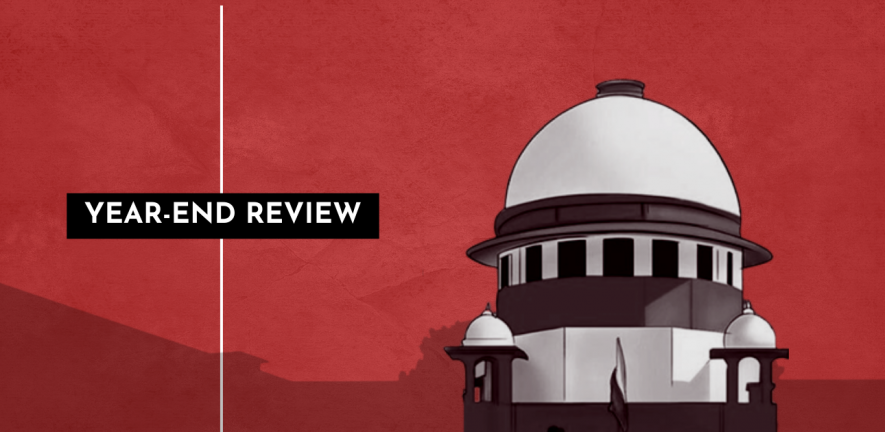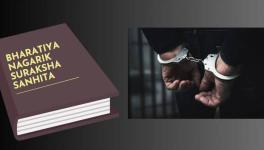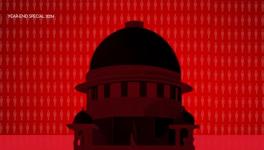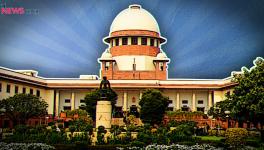Year-End Review of the Supreme Court’s Record

The CJI and the collegium members stand at the cusp of history with the present majoritarian government in power for two terms and an election due in 2024. Whether the Supreme Court will provide leadership and be up to the task of holding the constitutional line is an open question. But it would be tragic if the judiciary fails to recognise the moment in history where it is poised.
—–
It is customary for all publications to review developments at this year-end festive season as we have been doing. However, there is nothing to celebrate as sadly, the most depressing event occurred in December and so, we must begin the year backward.
Beginning the year backward— the travesty with Bilkis Bano
A Supreme Court bench comprised of Justices Ajay Rastogi and Vikram Nath rejected on December 13, just three days before the court closed, a sound review petition filed by Bilkis Bano. The review petition made out a case, in that Bilkis was never heard and there was a sufficient body of judicial opinion that held that an application for remission is to be made to the appropriate government within whose jurisdiction the conviction had occurred. Following this line of case law, the convicts’ application for remission ought to have been made to the state of Maharashtra, which was not done; instead it was made to the state of Gujarat. The very reason why the trial was transferred from Gujarat to Maharashtra was on account of the fact that in the perception of the court and having regard to the mass hysteria prevailing in Gujarat against the minority community, justice would be better served outside the state of Gujarat.
The review petition, filed much earlier, was rejected only after the results of the Gujarat elections were announced. The very party which was in power when the atrocity against Bilkis Bano took place in 2002, was also in power when the remission was granted to the eleven convicts.
Reason and logic demand that a curative petition be filed, heard, and disposed of before or along with the writ petition, which has been filed challenging the release of the eleven convicts on the remission.
The facts relating to what happened to her are well known. Nevertheless, they bear repeating. The order of the conviction notes that, “When they saw the group of prosecutrix, they stopped their vehicles. They started shouting “Musalmano ko Maro” and ran towards the group of prosecutrix. These persons who came in the two white vehicles, were carrying swords, lathis and sickles in their hands. From the group of persons who attacked them, the prosecutrix identified accused nos.1 to 12. Accused no.4 – Shailesh Chimanlal Bhatt pulled Saleha the daughter of prosecutrix, from her arms and smashed her on the ground due to which Saleha died. Accused no.1 Jaswantbhai Chaturbhai Nai who was holding a sword, was going to assault the prosecutrix with a sword, however, she held out her hand to ward-off the blow, due to which, she received injury on her left hand. Accused nos.1, 2 and 3 forcibly removed the clothes of the prosecutrix and committed rape on her. First she was raped by accused no.1 – Jaswantbhai Chaturbhai Nai, then by accused no. 2 – Govindbhai Nai and thereafter by accused no.3 Naresh Modhiya. The other accused persons i.e. accused nos. 5 to 12 in the meanwhile, tore off the clothes of the other females in the group and committed rape on them and assaulted the male members in their group. In the meanwhile, on account of rape, the prosecutrix became unconscious. She was unconscious for many hours. When she regained consciousness, she found her relatives lying dead, including Shamim’s baby. The prosecutrix was totally naked. She found one petticoat (Lengah) nearby. She wore the same and crawled upto the hill-top and hid there. The next day morning, she came down on the other side of the hill.” For this, they were sentenced and it is for this, that they have been granted remission.
The Supreme Court Collegium faces an existential crisis in the face of the attack it is facing under the ruling dispensation. While the system itself requires to bear in mind the need for diversity of judicial appointments, surely the cure is worse than the disease.
The ruling of the Supreme Court that the Gujarat government was the appropriate government not only flies in the face of binding precedent, but makes a mockery of the transfer of the trial from Gujarat to Maharashtra. The court, while holding that the Gujarat Government was the appropriate government, flew in the face of Section 432(7) of the Criminal Procedure Code which holds that the trial was transferred to Maharashtra under ‘exceptional circumstance’. This turns the law on its head, since the only reasons for transferring the trial out of the state are exceptional, making the transferee state the appropriate government to decide on the remission.
When brought to the notice of the Court that Bilkis Bano was not heard, nor was her name mentioned in the writ petition under Article 32 of the Constitution, one would have expected the court to self-correct, which is what the review petitions are all about. After all, the rapes and murders occurred in the face of genocidal violence never to be forgotten. Thus far, many of us have given the benefit of doubt to the judges since the petition filed by the released convicts did not disclose details of the nature of the case, nor revealed the name of Bilkis Bano, nor referred to the genocide of 2002, nor mentioned the horrific nature of the crime. The review brought all this on record, and one would have expected that the court would give Bilkis her day in court. This is surely a case where the injustice done to her could have been undone.
Justice Khanwilkar’s judgements lacked any awareness of the need to protect human rights and liberty.
This is a classic case for a curative petition to be heard and filed by a Constitution bench of five judges since it satisfies all the criteria for a curative petition as laid down in the Supreme Court’s Rupa Ashok Hurra judgment of 2002.
While there is a writ petition pending, we believe that a curative petition, where the court cures the injustice before proceeding to do justice is a must. Reason and logic demand that a curative petition be filed, heard, and disposed of before or along with the writ petition, which has been filed challenging the release of the eleven convicts on the remission.
The three Chief Justices
It is a year which saw three Chief Justices of India (‘CJI’) in offices – CJIs N.V. Ramana, U.U. Lalit and Dr. D.Y. Chandrachud – which is an altogether unseen phenomenon in itself. While CJI Ramanna retired with a bang, having decided to relook at its judgment on the interpretation of certain provisions of the Prevention of Money Laundering Act (‘PMLA’), albeit in a limited fashion, CJI Lalit went on to receive great praise from jurists and academics for his dissent in the Economically Weak Section reservation judgment. But a dissent is nothing more than a dissent and nothing succeeds like success.
Post retirement appointments without an appropriate cooling off period of two years require condemnation in that they interfere with judicial independence.
He would himself, rather pride himself for the systems he put in place for speedy disposal of cases, dividing court time between miscellaneous and final hearing matters, placing long hidden issues of constitutional importance for hearings and setting up three constitutional benches which functioned together.
On a simple request, based on the letter placed by me, he also commenced live streaming of Supreme Court proceedings before Constitution benches, which was pending since 2018.
He was a man with a mission and accomplished what he set out to do in a period of 74 days of work. Few can claim to leave a mark on the Indian legal system in such a brief period. He was much loved by the Bar, having been recruited from there.
However, his listing of the Dr. G.N. Saibaba case on a Saturday before a bench of two judges, both drawn from Gujarat, does call for criticism of a serious nature. To begin with, the court has always risen to the occasion even on holidays and in vacation in defence of liberty, and not against it. It appears to be the first recorded case in the history of the Supreme Court in which its jurisdiction was invoked to keep people in incarceration, rather than to release them urgently. That apart, his ex post facto clarification of the choice has not convinced many. This was all the more alarming given his known history of being liberal in the matter of grant of bail, not only generally, but also to known political activists.
This brings us to the tenure of Chief Justice Dr. Chandrachud, who has been in office for over a month now. For reasons best known to him, he has announced that there will be no vacation sitting of the Supreme Court. In the matter of administrative reform, he has dealt with low hanging fruits, of transfer petitions, which are mostly matrimonial cases and bail applications, and assigned them to all courts.
For this, we must be grateful; as he himself said, the Supreme Court exists to do justice for the smallest and the most insignificant of people. This being said, at a recent felicitation by the bar associations of Bombay, he commented in a lighter vein that he is in a danger of losing his judicial persona and being appropriated by the larger civil society as a ‘politician’ in that the invitations to deliver lectures never stop. No doubt, he will have a tough time which invites to accept and which ones to reject, but as has been well said, a judge primarily speaks through his judgments.
Attack on the Supreme Court
The Supreme Court faces an existential crisis in the face of the attack it is facing under the ruling dispensation. It is now more than obvious from the speeches made by the Union Law Minister and the Vice President that the Collegium is under attack. While the system itself requires to bear in mind the need for diversity of judicial appointments, surely the cure is worse than the disease.
Sooner, if not later, the entire court led by CJI Dr. Chandrachud will have to meet the challenge of protecting the independence of the judiciary at judicial and non-judicial fora. While it is true that under Article 122, the conduct of a judge cannot be discussed in the public or in Parliament except for the purpose of impeachment. Debates on the system of appointment will not fall within the purview of Article 122.
Such debates have occurred throughout history. However, if such debates cross the line, and cease to be debates about the manner and matter of appointment of judges generally or relate to matters which are sub judice, thus entering the realm of violation of the law, surely a case for contempt is made out, no matter the high office occupied by the persons making the attack.
Whilst it is true that there is a total lack of transparency in the Collegium, particularly with regard to its discussions, this is a matter for self-correction and does not call for reversing the methods of appointing judges and handing over the power to the executive. Towards this end, the collegium must show greater transparency in its functioning and greater diversity on the Bench.
A recent Supreme Court decision has taken the view that the discussions in the collegium being oral, and its minutes not recorded, cannot fall within the meaning of ‘information’ under the Right to Information Act. This is a clever device to avoid accountability, which convinces no one.
As The Leaflet has reported, there has been two cases where names have been twice recommended by the collegium and twice rejected by the government (which is contrary to law); they have been subsequently withdrawn by the collegium itself. Since there is no information as to how and when this happened, it is difficult to hold any set of collegium members responsible, but one can say that this collapse occurred from within. No amount of external attacks alone from the executive can lead to a collapse of the independence of the judiciary, but there has to be a willingness from within to shake hands with the executive. It is here that the Bar will have to play a role in standing up for the independence of the judiciary.
If Saurabh Kirpal’s recommendation is not reiterated, it will surely expose the hypocrisy of the Supreme Court authoring judgements on decriminalising Section 377 of the Indian Penal Code and not enabling the appointment of a gay person as a judge.
The CJI and the collegium members stand at the cusp of history with the present majoritarian government in power for two terms and an election due in 2024. The erosion of constitutional values by an irresponsible executive, the deliberate attack on secularism, the narrative of cultural nationalism as being over and above the Constitution, and the hatred for minorities and for liberalism is now well-documented across the country and in court decisions. Added to this is the attack on civil society and NGOs as being ‘urban naxals’ who require to be eliminated or put away in prisons.
Whether the Supreme Court will provide leadership and be up to the task of holding the constitutional line is an open question. But it would be tragic if the judiciary fails to recognise the moment in history where it is poised. While the Emergency was presented to us on black and white on paper, we have seen what lawyer, writer and researcher Arvind Narrain calls an ‘Undeclared Emergency’. The court so far has maintained an uncanny silence, and the dismissal of the review petition in the Bilkis Bano case is a part of the uncanny silence. But we can only say that the battle has just begun, and lawyers will play an important role.
Bail jurisprudence
Bail jurisprudence was something to cheer about this year. The Bombay High Court granted bail to academic and activist Dr. Anand Teltumbde, which was upheld by the Supreme Court. But the jurisprudence is still on shaky ground. A stark example of this was the denial of bail to activist Umar Khalid by the Delhi High Court, and to activist Jyoti Jagtap by the Bombay High Court.
Justice A.M. Khanwilar’s judgement on the eve of his retirement which sent journalist and activist Teesta Setalwad, and retired Indian Police Services officer R.B. Sreekumar, straight to prison, was another judicial first. Similarly, the credentials of activist Himanshu Gupta, questioned by a Supreme Court bench and ordered by Justice J.B. Pardiwala, ensured a similar fate.
The Supreme Court seems to have taken one step forward and one step backward, bringing us to a standstill. Of special mention must be the retirement of Justice Khanwilkar for his judgments which lacked any awareness of the need to protect human rights and liberty. As mentioned earlier, it was the judgement authored by him given by a bench headed by in the PMLA case that eroded all judicial standards of the right against incrimination, which found universal rejection; however, the PMLA judgement was reopened before the ink on it was dry.
Disturbing trends
News has just arrived that the Union Government has appointed Justice Hemant Gupta, who recently retired as a judge from the Supreme Court, as Chairperson of the New Delhi International Arbitration Centre.
Post retirement appointments without an appropriate cooling off period of two years require condemnation in that they interfere with judicial independence. It must not be forgotten that Justice Gupta upheld the ban on the hijab in Karnataka a few weeks before his retirement.
History will record whether our courts will allow culture to trump the Constitution.
Similarly, Justice Ritu Raj Awasthi, the then Chief Justice of the Karnataka High Court, who authored the high court’s judgement on hijab, has now been appointed to head the Law Commission of India. When will we see the end of this form of interference with the independence of the judiciary? It was no less than the Bharatiya Janta Party’s (‘BJP’) own ideologue, Arun Jaitley who said that judges should not be appointed to public posts soon after retirement as it affected the independence of the judiciary.
Pendency continues
While the three Constitution benches found their way through courts, apart from the EWS judgement, we have not seen any judgements delivered on demonetisation, Jallikattu, the appointment of election commissioners, or the dissolution of marriage under Article 142 of the Constitution. Nor have the cases relating to the Citizenship Amendment Act, the challenge to Section 6A of the Citizenship Act, the challenge to electoral bonds or the abrogation of Article 370 of the Constitution been taken up for a substantive hearing.
At the same time, the Maharashtra government continues to stand on a slender interim order by the Supreme Court, with no one knowing whether it is a legitimate government. It must be the first instance of a state government in power not knowing whether it is unconstitutional or not for a prolonged period. Predictions are that before the pronouncement, elections will be called in Maharashtra, making the exercise a fruitless one.
Appointment of judges
“Finally, we saw the appointment of three judges, one of whom was Justice Dipankar Datta, whose appointment was held up by a good two months. We also learnt that the Union Government has rejected the appointment of openly gay lawyer Saurabh Kirpal as a Delhi High Court judge for reasons which are not in public domain but the fact that his partner is a foreign national. To his credit, Kirpal has refused to withdraw his consent to be a judge, as he said, “I am doing this for a community, and not myself”.
If his recommendation is not reiterated, it will surely expose the hypocrisy of the Supreme Court authoring judgements on decriminalising Section 377 of the Indian Penal Code and not enabling the appointment of a gay person as a judge. What made it look like a deal was the recommendation of five names for appointment as Supreme Court judges soon thereafter, with not a single Scheduled Caste, Scheduled Tribe or woman judge amongst them. It was a matter of great disappointment for right-minded people.
There remains, only one vacancy at the Supreme Court now, and perhaps will be filled by a token judge. It is not as if no women judges were available for appointment to the Supreme Court. The Allahabad High Court had a fairly senior female judge, even if not of the same seniority as the appointed judges. She should have been considered and elevated.
Final word
A strange conversation appears to be going on between the government and the judiciary. The government is commenting on issues pending in court. Recently, Rajya Sabha Member Sushil Kumar Modi of the BJP stated that Indian culture does not recognise same-sex marriage, knowing fully well the matter is pending in court.
Our courts do not need dog whistles or advice on sub judice matters. When it suits the government to not answer the questions, they conveniently say, “No comment, the matter is sub judice”. At other times, culture is invoked against the Constitution.
History will record whether our courts will allow culture to trump the Constitution; I sincerely hope not. The burden is on the shoulders of the legal profession to protect the judiciary against all attacks from a powerful majoritarian government.
Indira Jaising is a noted human rights lawyer and a senior advocate at the Supreme Court of India. She is also a co-founder of The Leaflet.
Get the latest reports & analysis with people's perspective on Protests, movements & deep analytical videos, discussions of the current affairs in your Telegram app. Subscribe to NewsClick's Telegram channel & get Real-Time updates on stories, as they get published on our website.
























